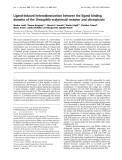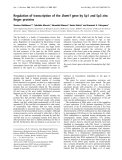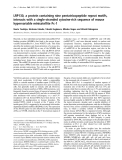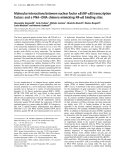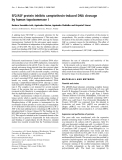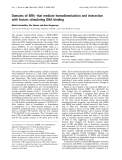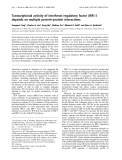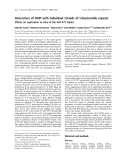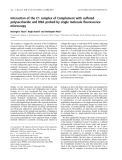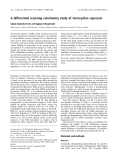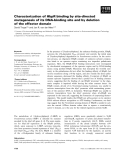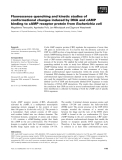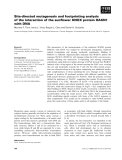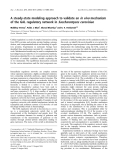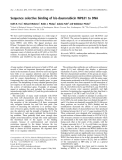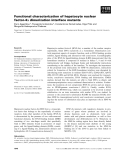
DNA binding interactions
-
The presence of heterocyclic moiety in diverse compounds, strongly indicative of the desired effect on physiological activity, and it reflects on efforts to find useful synthetic drugs.
 12p
12p  tocectocec
tocectocec
 25-05-2020
25-05-2020
 19
19
 2
2
 Download
Download
-
The insect ecdysteroid receptor consists of a heterodimer between EcR and the RXR-orthologue, USP. We addressed the question of whether this heterodimer, like all other RXR heterodimers, may be formed in the absence of ligand and whether ligand promotes dimerization. We found that C-terminal protein fragments that comprised the ligand binding, but not the DNA binding domain of EcR and USP and which were equipped with the activation or DNA binding region of GAL4, respectively, exhibit a weak ability to interact spontaneously with each other.
 9p
9p  system191
system191
 01-06-2013
01-06-2013
 31
31
 3
3
 Download
Download
-
The Sp family is a family of transcription factors that bind to cis-elements in the promoter regions of various genes. Regulation of transcription by Sp proteins is based on interactions between a GC-rich binding site (GGGCGG) in DNA and C-terminal zinc finger motifs in the proteins. In this study, we characterized the GC-rich promoter of the gene for the DNA methyltransferase (Dnmt1) that is responsible for methylation of cytosine residues in mammals and plays a role in gene silencing.
 10p
10p  system191
system191
 01-06-2013
01-06-2013
 40
40
 4
4
 Download
Download
-
Recently, we have identified and purified minisatellite DNA binding proteins (MNBPs) that bind to the mouse hypervariable minisatellite Pc-1, from NIH3T3 cells. This study describes the isolation and characterization of a mouse leucine-rich protein (mLRP130) as one of the MNBPs that binds to the C-rich strand of Pc-1. The mLRP130 cDNA was demonstrated to encode a polypeptide of 1306 aminoacid residues with a deduced molecular mass of 137 kDa, and the mLRP130 mRNA is detected in various organs, including heart, brain, liver, skeletal muscle, kidneys and testes.
 7p
7p  system191
system191
 01-06-2013
01-06-2013
 26
26
 4
4
 Download
Download
-
The decoy approach against nuclear factor kB (NF-kB) is a useful tool to alter NF-kB dependent gene expression using synthetic oligonucleotides (ODNs) carrying NF-kB specific cis-elements. Unfortunately, ODNs are not stable and need to be extensively modified to be used in vivo or ex vivo. We have previously evaluated the possible use of peptide nucleic acids (PNAs) as decoy molecules. The backbone of PNAs is composed of N-(2-aminoethyl)glycine units, rendering these molecules resistant to both nucleases and proteases.
 10p
10p  system191
system191
 01-06-2013
01-06-2013
 45
45
 4
4
 Download
Download
-
A splicing factor SF2/ASF is a natural substrate for the kinase activity of human topoisomerase I. This study demonstrates that SF2/ASF inhibits DNA cleavage by human topoisomerase I induced by the anti-cancer agent camptothecin. The inhibition is independent of the phosphorylation status of SF2/ASF. We show that the inhibition did not result from binding of SF2/ASF to DNA that would hinder interactions between topoisomerase I and DNA. Neither it was a consequence of a loss of sensitivity of the enzyme to camptothecin.
 7p
7p  research12
research12
 01-06-2013
01-06-2013
 42
42
 5
5
 Download
Download
-
The estrogen receptor-related receptorc (ERRc/ERR3/ NR3B3) is an orphan member of the nuclear receptor superfamily closely related to the estrogen receptors. To explore the DNA binding characteristics, the protein–DNA interaction was studied in electrophoretic mobility shift assays (EMSAs). In vitro translated ERRc binds as a homodimer to direct repeats (DR) without spacing of the nuclear receptor half-site 5¢-AGGTCA-3¢(DR-0), to exten-dedhalf-sites, and to the inverted estrogen response element....
 12p
12p  research12
research12
 23-04-2013
23-04-2013
 23
23
 3
3
 Download
Download
-
Virus infection results in the activation of a set of cellular genes involved in host antiviral defense. IRF-3 has been identifiedas a critical transcription factor in this process. The activationmechanismof IRF-3 is not fully elucidated,yet it involves a conformational change triggered by the virus-dependent phosphorylation of its C-terminus. This con-formational change leads to nuclear accumulation,DNA binding and transcriptional transactivation.
 10p
10p  tumor12
tumor12
 22-04-2013
22-04-2013
 40
40
 3
3
 Download
Download
-
The humanSUV3gene encodes an NTP-dependent DNA⁄RNA DExH box helicase predominantly localized in mitochondria. Its orthologue in yeast is a component of the mitochondrial degradosome complex involved in the mtRNA decay pathway. In contrast to this, the physiological func-tion of human SUV3remains to be elucidated. In this report we demon-strate that the hSuv3 protein interacts with HBXIP, previously identified as a cofactor of survivin in suppression of apoptosis and as a protein that binds the HBx protein encoded by the hepatitis B virus....
 12p
12p  fptmusic
fptmusic
 12-04-2013
12-04-2013
 39
39
 3
3
 Download
Download
-
The structural changes produced by the minor-groove binding ligand DAPI (4¢,6-diamidine-2-phenylindole) on individual strands of trinucleotide repeat sequences were detectedby electrophoreticband-shift analysis andrelated to their effects on DNA replication in vitro. Among the 20 possible single-stranded trinucleotide repeats, only theT-rich strand of the AATÆATT triplet exhibits an observable fluorescence band and a change in electrophoretic mobility due to the drug binding.
 7p
7p  fptmusic
fptmusic
 12-04-2013
12-04-2013
 46
46
 4
4
 Download
Download
-
The complex C1 triggers the activation of the Complement classical pathway through the recognition and binding of antigen–antibody complex by its subunit C1q. The globular region of C1q is responsible for C1 binding to the immune complex. C1q can also bind nonimmune molecules such as DNAand sulfated polysaccharides, leading either to the activation or inhibition of Complement. The binding site of these nonimmune ligands is debated in the literature, and it has beenproposed to be located either in the globular region or in the collagen-like regionof C1q, or inboth....
 7p
7p  fptmusic
fptmusic
 12-04-2013
12-04-2013
 41
41
 2
2
 Download
Download
-
Tetracycline repressor (TetR), which constitutes the most commonmechanismof bacterial resistance to an antibiotic, is a homodimeric protein composed of two identical sub-units, each of which contains a domain possessing a helix– turn–helix motif and a domain responsible for binding tetra-cycline. Binding of tetracycline in the protein pocket is accompanied by conformational changes in TetR, which abolish the specific interaction between the protein and DNA.
 10p
10p  fptmusic
fptmusic
 12-04-2013
12-04-2013
 44
44
 2
2
 Download
Download
-
In the presence of 2-hydroxybiphenyl, the enhancer binding protein, HbpR, activates ther54-dependent PhbpC promoter and controls the initial steps of 2-hydroxybiphenyl degradation inPseudomonas azelaica. In the activa-tion process, an oligomeric HbpR complex of unknown subunit composi-tion binds to an operator region containing two imperfect palindromic sequences. Here, the HbpR–DNA binding interactions were investigated by site-directed mutagenesis of the operator region and by DNA-binding assays using purified HbpR. ...
 0p
0p  awards
awards
 06-04-2013
06-04-2013
 41
41
 2
2
 Download
Download
-
The ability ofEntamoeba histolyticaTATA binding protein (EhTBP) to interact with different TATA boxes in gene promoters may be one of the key factors to perform an efficient transcription in this human parasite. In this paper we used several TATA variants to study the in vitro EhTBP DNA-binding activity and to determine the TATA-EhTBP dissociation constants. The presence of EhTBP in complexes formed by nuclear extracts (NE) and the TATTTAAA oligonucleotide, which corresponds to the canonical TATA box for E. histolytica, was demonstrated by gel-shift assays. ...
 13p
13p  awards
awards
 06-04-2013
06-04-2013
 50
50
 2
2
 Download
Download
-
Cyclic AMP receptor protein (CRP) regulates the expression of more then 100 genes inEscherichia coli. It is known that the allosteric activation of CRP by cAMP involves a long-distance signal transmission from the N-ter-minal cAMP-binding domain to the C-terminal domain of CRP responsible for the interactions with specific sequences of DNA. In this report we have used a CRP mutant containing a single Trp13 located in the N-terminal domain of the protein.
 14p
14p  awards
awards
 05-04-2013
05-04-2013
 45
45
 4
4
 Download
Download
-
The interaction of the homeodomain of the sunflower KNOX protein HAKN1 with DNA was studied by site-directed mutagenesis, hydroxyl radical footprinting and missing nucleoside experiments. Binding of HAKN1 to different oligonucleotides indicated that HAKN1 prefers the sequence TGACA (TGTCA), with changes within the GAC core more pro-foundly affecting the interaction. Footprinting and missing nucleoside experiments using hydroxyl radical cleavage of DNA showed that HAKN1 interacts with a 6-bp region of the strand carrying the GAC core, covering the core and nucleotides towards the 3¢ end....
 13p
13p  awards
awards
 05-04-2013
05-04-2013
 41
41
 4
4
 Download
Download
-
Cellular regulation is a result of complex interactions arising from DNA–protein and protein–protein binding, autoreg-ulation, and compartmentalization and shuttling of regula-tory proteins. Experiments in molecular biology have identified these mechanisms recruited by a regulatory net-work.Mathematicalmodelsmaybe used to complement the knowledge-base provided byin vitroexperimental methods. Interactions identified byin vitroexperiments can lead to the hypothesis of multiple candidate models explaining the in vivo mechanism. ...
 11p
11p  awards
awards
 05-04-2013
05-04-2013
 53
53
 3
3
 Download
Download
-
RNA helicase A (RHA), a member of DNA and RNA helicase family containing ATPase activity, is involved in many steps of gene expression such as transcription and mRNA export. RHA has been reported to bind directly to the transcriptional coactivator, CREB-binding protein, and the tumor suppressor protein, BRCA1, and links them to RNAPolymerase II holoenzyme complex. Using yeast two-hybrid screening, we have identified RHA as an interacting molecule of the p65 subunit of nuclear factorjB(NF-jB).
 11p
11p  awards
awards
 05-04-2013
05-04-2013
 32
32
 4
4
 Download
Download
-
We have used footprinting techniques on a wide range of natural and synthetic footprinting substrates to examine the sequence-selective interaction of the bis-daunorubicin anti-biotic WP631 with DNA. The ligand produces clear DNase I footprints that are very different from those seen with other anthracycline antibiotics such as daunorubicin and nogalamycin. Footprints are found in a diverse range of sequences, many of which are rich inGT (AC) or GA (TC) residues.
 11p
11p  dell39
dell39
 03-04-2013
03-04-2013
 65
65
 3
3
 Download
Download
-
Hepatocyte nuclear factor-4 (HNF-4a), a member of the nuclear receptor superfamily, binds DNA exclusively as a homodimer. Dimerization con-trols important aspects of receptor function, such as DNA binding, protein stability, ligand binding and interaction with coactivators.
 11p
11p  inspiron33
inspiron33
 26-03-2013
26-03-2013
 48
48
 5
5
 Download
Download
CHỦ ĐỀ BẠN MUỐN TÌM








![5-[Substituted]-1, 3, 4-thiadiazol-2-amines: Synthesis, Spectral Characterization, and Evaluation of their DNA interactions 5-[Substituted]-1, 3, 4-thiadiazol-2-amines: Synthesis, Spectral Characterization, and Evaluation of their DNA interactions](https://tailieu.vn/image/document/thumbnail/2020/20200525/tocectocec/135x160/1001590394742.jpg)
